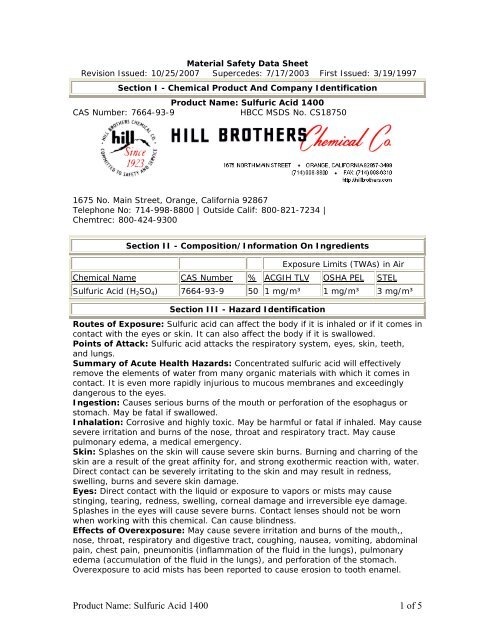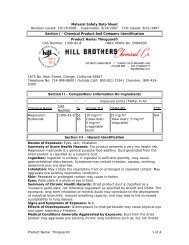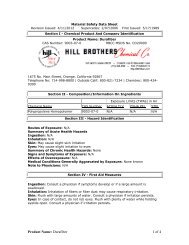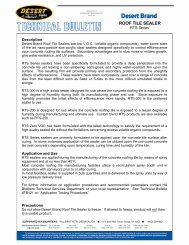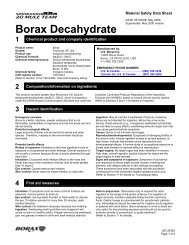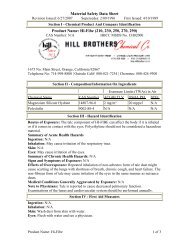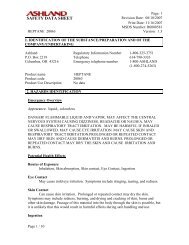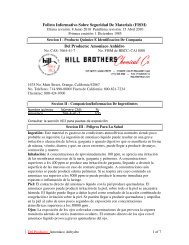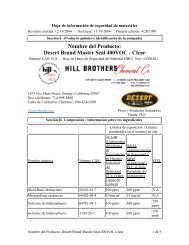sulfuric acid 1400 1 of 5 - Hill Brothers Chemical Co.
sulfuric acid 1400 1 of 5 - Hill Brothers Chemical Co.
sulfuric acid 1400 1 of 5 - Hill Brothers Chemical Co.
Create successful ePaper yourself
Turn your PDF publications into a flip-book with our unique Google optimized e-Paper software.
Material Safety Data Sheet<br />
Revision Issued: 10/25/2007 Supercedes: 7/17/2003 First Issued: 3/19/1997<br />
Section I - <strong>Chemical</strong> Product And <strong>Co</strong>mpany Identification<br />
Product Name: Sulfuric Acid <strong>1400</strong><br />
CAS Number: 7664-93-9<br />
HBCC MSDS No. CS18750<br />
1675 No. Main Street, Orange, California 92867<br />
Telephone No: 714-998-8800 | Outside Calif: 800-821-7234 |<br />
Chemtrec: 800-424-9300<br />
Section II - <strong>Co</strong>mposition/Information On Ingredients<br />
Exposure Limits (TWAs) in Air<br />
<strong>Chemical</strong> Name CAS Number % ACGIH TLV OSHA PEL STEL<br />
Sulfuric Acid (H 2 SO 4 ) 7664-93-9 50 1 mg/m³ 1 mg/m³ 3 mg/m³<br />
Section III - Hazard Identification<br />
Routes <strong>of</strong> Exposure: Sulfuric <strong>acid</strong> can affect the body if it is inhaled or if it comes in<br />
contact with the eyes or skin. It can also affect the body if it is swallowed.<br />
Points <strong>of</strong> Attack: Sulfuric <strong>acid</strong> attacks the respiratory system, eyes, skin, teeth,<br />
and lungs.<br />
Summary <strong>of</strong> Acute Health Hazards: <strong>Co</strong>ncentrated <strong>sulfuric</strong> <strong>acid</strong> will effectively<br />
remove the elements <strong>of</strong> water from many organic materials with which it comes in<br />
contact. It is even more rapidly injurious to mucous membranes and exceedingly<br />
dangerous to the eyes.<br />
Ingestion: Causes serious burns <strong>of</strong> the mouth or perforation <strong>of</strong> the esophagus or<br />
stomach. May be fatal if swallowed.<br />
Inhalation: <strong>Co</strong>rrosive and highly toxic. May be harmful or fatal if inhaled. May cause<br />
severe irritation and burns <strong>of</strong> the nose, throat and respiratory tract. May cause<br />
pulmonary edema, a medical emergency.<br />
Skin: Splashes on the skin will cause severe skin burns. Burning and charring <strong>of</strong> the<br />
skin are a result <strong>of</strong> the great affinity for, and strong exothermic reaction with, water.<br />
Direct contact can be severely irritating to the skin and may result in redness,<br />
swelling, burns and severe skin damage.<br />
Eyes: Direct contact with the liquid or exposure to vapors or mists may cause<br />
stinging, tearing, redness, swelling, corneal damage and irreversible eye damage.<br />
Splashes in the eyes will cause severe burns. <strong>Co</strong>ntact lenses should not be worn<br />
when working with this chemical. Can cause blindness.<br />
Effects <strong>of</strong> Overexposure: May cause severe irritation and burns <strong>of</strong> the mouth,,<br />
nose, throat, respiratory and digestive tract, coughing, nausea, vomiting, abdominal<br />
pain, chest pain, pneumonitis (inflammation <strong>of</strong> the fluid in the lungs), pulmonary<br />
edema (accumulation <strong>of</strong> the fluid in the lungs), and perforation <strong>of</strong> the stomach.<br />
Overexposure to <strong>acid</strong> mists has been reported to cause erosion to tooth enamel.<br />
Product Name: Sulfuric Acid <strong>1400</strong> 1 <strong>of</strong> 5
Medical <strong>Co</strong>nditions Generally Aggravated by Exposure: Persons with preexisting<br />
skin disorders and/or respiratory disorders (e.g. Asthma-like conditions)<br />
may be more susceptible to the effects <strong>of</strong> this material, and may be aggravated by<br />
exposure to this material.<br />
Note to Physicians: Sulfuric <strong>acid</strong> is reported to cause pulmonary function<br />
impairment. Periodic surveillance is indicated. Sulfuric <strong>acid</strong> may cause acute lung<br />
damage. Surveillance <strong>of</strong> the lungs is indicated. Ingestion may cause<br />
gastroesophageal perforation. Perforation may occur within 72 hours, but along with<br />
abscess formation, can occur weeks later. Long term complications may include<br />
esophageal, gastric or pyloric strictures or stenosis.<br />
Section IV - First Aid Measures<br />
Ingestion: If liquid <strong>sulfuric</strong> <strong>acid</strong> or solutions containing <strong>sulfuric</strong> <strong>acid</strong> have been<br />
swallowed and the person is conscious, give him one glass <strong>of</strong> water (1/2 glass <strong>of</strong><br />
water to children under 5), immediately to dilute the <strong>sulfuric</strong> <strong>acid</strong>. Do NOT induce<br />
vomiting. Do not attempt to make the exposed person vomit. Do not leave victim<br />
unattended. GET MEDICAL ATTENTION IMMEDIATELY.<br />
Inhalation: If a person breathes in large amounts <strong>of</strong> <strong>sulfuric</strong> <strong>acid</strong>, move the<br />
exposed person to fresh air at once. If breathing has stopped, perform artificial<br />
respiration. If breathing is difficult, give oxygen. Keep the affected person warm and<br />
at rest. GET MEDICAL ATTENTION AS SOON AS POSSIBLE.<br />
Skin: If liquid <strong>sulfuric</strong> <strong>acid</strong> or solutions containing <strong>sulfuric</strong> <strong>acid</strong> get on the skin,<br />
immediately flush the contaminated skin with water for at least 15 minutes. If skin<br />
surface is damaged, apply a clean dressing. If liquid <strong>sulfuric</strong> <strong>acid</strong> or solutions<br />
containing <strong>sulfuric</strong> <strong>acid</strong> penetrate through the clothing, immediately remove the<br />
clothing, shoes and constrictive jewelry under a safety shower and continue to wash<br />
the skin for at least 15 minutes. GET MEDICAL ATTENTION IMMEDIATELY.<br />
Eyes: If liquid <strong>sulfuric</strong> <strong>acid</strong> or solutions containing <strong>sulfuric</strong> <strong>acid</strong> get into the eyes,<br />
flush eyes immediately with a directed stream <strong>of</strong> water for at least 30 minutes while<br />
forcibly holding eyelids apart to ensure complete irrigation <strong>of</strong> all eye and lid tissue.<br />
GET MEDICAL ATTENTION IMMEDIATELY. <strong>Co</strong>ntact lenses should not be worn when<br />
working with this chemical.<br />
Section V - Fire Fighting Measures<br />
Flash Point: Non-flammable Autoignition Temperature: N/A<br />
Lower Explosive Limit: N/A Upper Explosive Limit: N/A<br />
Unusual Fire and Explosion Hazards: Not flammable but highly reactive and<br />
capable <strong>of</strong> igniting finely divided combustible materials on contact. Reacts violently<br />
with water and organic materials with evolution <strong>of</strong> heat. If involved in fire, may<br />
release hazardous oxides <strong>of</strong> sulfur. Vapors are heavier than air and may accumulate<br />
in low areas. <strong>Co</strong>ntainers exposed to extreme heat may ruputure due to pressure<br />
buildup. <strong>Co</strong>ntact with common metals may generate hydrogen, which can form<br />
flammable mixture with air.<br />
Extinguishing Media: Fires involving small amount <strong>of</strong> combustibles may be<br />
smothered with suitable dry chemical, soda ash, lime, sand or CO2. Use water on<br />
combustibles burning in vicinity <strong>of</strong> this material but use care as water applied directly<br />
to this <strong>acid</strong> results in evolution <strong>of</strong> heat and causes splattering.<br />
Special Firefighting Procedures: Causes severe, deep burns to tissue; very<br />
corrosive effect. Avoid any contact. Wear full protective clothing and self-contained<br />
breathing apparatus. Sulfuric Acid is extremely slippery.<br />
Product Name: Sulfuric Acid <strong>1400</strong> 2 <strong>of</strong> 5
Section VI - Accidental Release Measures<br />
If <strong>sulfuric</strong> <strong>acid</strong> is spilled or leaked, ventilate area. <strong>Co</strong>llect spilled or leaked material in<br />
the most convenient and safe manner for reclamation or for disposal in a secured<br />
sanitary landfill. Sulfuric <strong>acid</strong> should be absorbed in vermiculite, dry sand, earth, or a<br />
similar material. It may also be diluted and neutralized. Add slowly to solution <strong>of</strong><br />
soda ash and slaked lime with stirring. Use Caution around spill area, Sulfuric Acid is<br />
extremely slippery. Stay upwind and away from spill release.<br />
Section VII - Handling and Storage<br />
Protect against physical damage and water. Keep containers closed. Sulfuric Acid is<br />
extremely slippery. Do not enter confined spaces such as tanks or pits without<br />
following proper entry procedures such as ASTM D-4276. To prevent ignition <strong>of</strong><br />
hydrogen gas generated in metal containers (from metal contact) smoking, open<br />
flames and sparks must not be permitted in storage areas. This product has a great<br />
affinity for water, abstracting it from the air and also from many organic substances;<br />
hence it will char wood, etc.. When diluting, the <strong>acid</strong> should be added to the diluent.<br />
Other Precautions: Persons not wearing protective equipment and clothing should<br />
be restricted from areas <strong>of</strong> spills or leaks until cleanup has been completed.<br />
Section VIII - Exposure <strong>Co</strong>ntrols/Personal Protection<br />
Respiratory Protection: If the exposure limit is exceeded and engineering controls<br />
are not feasible, a full facepiece respirator with an <strong>acid</strong> gas cartridge and particulate<br />
filter (NIOSH type N100 filter) may be worn up to 50 times the exposure limit, or the<br />
maximum use concentration specified by the appropriate regulatory agency or<br />
respirator supplier, whichever is lowest. If oil particles (e.g. lubricants, cutting fluids,<br />
glycerine, etc.) are present, use a NIOSH type R or P particulate filter. For<br />
emergencies or instances where the exposure levels are not known, use a fullfacepiece<br />
positive-pressure, air-supplied respirator. WARNING: Air purifying<br />
respirators do not protect workers in oxygen-deficient atmospheres.<br />
Ventilation: General mechanical ventilation may be sufficient to keep <strong>sulfuric</strong> <strong>acid</strong><br />
vapor concentrations within specified time-weighted TLV range. If general ventilation<br />
proves inadequate to maintain safe vapor concentrations, supplemental local exhaust<br />
may be required.<br />
Protective Clothing: Employees should be provided with and required to use<br />
impervious clothing, gloves, face shields (eight-inch minimum), and other<br />
appropriate protective clothing necessary to prevent any possibility <strong>of</strong> skin contact<br />
with liquid <strong>sulfuric</strong> <strong>acid</strong> or solutions containing more than 1% <strong>sulfuric</strong> <strong>acid</strong> by weight.<br />
Eye Protection: Employees should be provided with and required to use splashpro<strong>of</strong><br />
safety goggles where there is any possibility <strong>of</strong> liquid <strong>sulfuric</strong> <strong>acid</strong> or solutions<br />
containing <strong>sulfuric</strong> <strong>acid</strong> contacting the eyes. <strong>Co</strong>ntact lenses should not be worn when<br />
working with this chemical.<br />
Other Protective Clothing or Equipment: Rubber apron, rubber boots, eyewash<br />
stations and safety showers must be available in the immediate work area for<br />
emergency use.<br />
Work/Hygienic Practices: Avoid contact with the skin and avoid breathing vapors.<br />
Do not eat, drink, or smoke in work area. Wash hands before eating, drinking, or<br />
using restroom.<br />
Section IX - Physical and <strong>Chemical</strong> Properties<br />
Physical State: Liquid pH: 1.0<br />
Melting Point/Range: 3° C; 37°F<br />
Boiling Point/Range: 260° F; 315° C<br />
Product Name: Sulfuric Acid <strong>1400</strong> 3 <strong>of</strong> 5
Appearance/<strong>Co</strong>lor/Odor: <strong>Co</strong>lorless to dark brown; odorless unless hot, then<br />
choking irritant.<br />
Solubility in Water: 100%<br />
Vapor Pressure(mmHg): 1 @<br />
145.8°F<br />
Specific Gravity(Water=1): 1.4 Molecular Weight: 98<br />
Vapor Density(Air=1): 3.4<br />
Evaporation Rate (N-Butyl Acetate=1):<br />
< 1<br />
% Volatiles: Negligible<br />
Weight/Gallon: 10.79 Lbs.<br />
How to detect this compound : Sampling and analyses may be performed by<br />
collection <strong>of</strong> <strong>sulfuric</strong> <strong>acid</strong> on a cellulose membrane filter, followed by extraction with<br />
distilled water and isopropyl alcohol, treatment with perchloric <strong>acid</strong>, and titration<br />
with barium perchlorate. Also, detector tubes certified by NIOSH under 42 CFR Part<br />
84 or other direct-reading devices calibrated to measure <strong>sulfuric</strong> <strong>acid</strong> may be used.<br />
Section X - Stability and Reactivity<br />
Stability: Stable Hazardous Polymerization: Will not occur<br />
<strong>Co</strong>nditions to Avoid: Temperatures above 150°F, moisture.<br />
Materials to Avoid: <strong>Co</strong>ntact <strong>of</strong> <strong>acid</strong> with organic materials (such as chlorates,<br />
carbides, fulminates, and picrates), alkaline materials and water may cause fires and<br />
explosions. <strong>Co</strong>ntact <strong>of</strong> <strong>acid</strong> with metals may form toxic sulfur dioxide fumes and<br />
flammable hydrogen gas. <strong>Co</strong>ntact with hypochlorites (e.g., chlorine bleach), sulfides,<br />
or cyanides will produce toxic gases. Potassium permanganate.<br />
Hazardous Decomposition Products: Toxic gases and vapors (such as <strong>sulfuric</strong><br />
<strong>acid</strong> fume, sulfur dioxide, and carbon monoxide) may be released when <strong>sulfuric</strong> <strong>acid</strong><br />
decomposes. Decomposes to water and sulfur trioxide above 644 o F.<br />
Section XI - Toxicological Information<br />
Sulfuric <strong>acid</strong> mist severely irritates the eyes, respiratory tract, and skin.<br />
<strong>Co</strong>ncentrated <strong>sulfuric</strong> <strong>acid</strong> destroys tissue due to its severe dehydrating action,<br />
whereas the dilute form acts as a mild irritant due to <strong>acid</strong> properties. The LC50 <strong>of</strong><br />
mist <strong>of</strong> 1-micron particle size for an 8 hour exposure was 50 mg/m³ for adult guinea<br />
pigs and 18 mg/m³ for young animals. <strong>Co</strong>ntinuous exposure <strong>of</strong> guinea pigs to 2<br />
mg/m³ for 5 days caused pulmonary edema and thickening <strong>of</strong> the alveolar walls;<br />
exposure <strong>of</strong> guinea pigs to 2 mg/m³ for 1 hour caused an increase in pulmonary<br />
airway resistance from reflex bronchoconstriction. A worker sprayed in the face with<br />
liquid fuming <strong>sulfuric</strong> <strong>acid</strong> suffered skin burns <strong>of</strong> the face and body, as well as<br />
pulmonary edema from inhalation. Sequelae were pulmonary fibrosis, residual<br />
bronchitis, and pulmonary emphysema; in addition, necrosis <strong>of</strong> the skin resulted in<br />
marked scarring. In human subjects, concentrations <strong>of</strong> about 5 mg/m³ were<br />
objectionable, usually causing cough, an increase in respiratory rate, and impairment<br />
<strong>of</strong> ventilatory capacity. Workers exposed to concentrations <strong>of</strong> 12.6 to 35 mg/m³ had<br />
a markedly higher incidence <strong>of</strong> erosion and discoloration <strong>of</strong> teeth than was noted in<br />
unexposed individuals. Splashed in the eye, the concentrated <strong>acid</strong> causes extremely<br />
severe damage, <strong>of</strong>ten leading to blindness, whereas dilute <strong>acid</strong> produces more<br />
transient effects from which recovery may be complete. Repeated exposure <strong>of</strong><br />
workers to the mist causes chronic conjunctivitis, tracheobronchitis, stomatitis, and<br />
dermatitis, as well as dental erosion. While ingestion <strong>of</strong> the liquid is unlikely in<br />
ordinary industrial use, the highly corrosive nature <strong>of</strong> the substance may be<br />
expected to produce serious mucous membrane burns <strong>of</strong> the mouth and esophagus.<br />
Product Name: Sulfuric Acid <strong>1400</strong> 4 <strong>of</strong> 5
This material may be toxic to aquatic life.<br />
Section XII - Ecological Information<br />
Section XIII - Disposal <strong>Co</strong>nsiderations<br />
Sulfuric <strong>acid</strong> may be placed in sealed containers or absorbed in vermiculite, dry sand,<br />
earth, or a similar material and disposed <strong>of</strong> in a secured sanitary landfill. It may also<br />
be diluted and neutralized. Check with your Federal, State, and Local authorities as<br />
neutralized <strong>sulfuric</strong> <strong>acid</strong> may be allowed to be flushed down the drain.<br />
Section XIV - Transport Information<br />
DOT Proper Shipping Description : UN2796, Sulfuric Acid, 8, PG II<br />
Section XV - Regulatory Information<br />
Reportable Quantity: 1,000 Pounds (454 Kilograms) (92.68 Gal.)<br />
NFPA Rating: Health - 3; Flammability - 0; Instability – 2; Special Hazard - W<br />
0=Insignificant 1=Slight 2=Moderate 3=High 4=Extreme<br />
Carcinogenicity Lists: Yes NTP: No IARC Monograph: No OSHA Regulated: Yes<br />
Section 313 Supplier Notification: This product contains the following toxic<br />
chemcial(s) subject to the reporting requirements <strong>of</strong> SARA TITLE III Section 313 <strong>of</strong><br />
the Emergency Planning and <strong>Co</strong>mmunity Right-To Know Act <strong>of</strong> 1986 and <strong>of</strong> 40 CFR<br />
372:<br />
CAS # <strong>Chemical</strong> Name % By Weight<br />
7664-93-9 Sulfuric Acid 50<br />
Section XVI - Other Information<br />
Synonyms/<strong>Co</strong>mmon Names: Oil <strong>of</strong> Vitriol; Spirit <strong>of</strong> Sulfur; Hydrogen Sulfate;<br />
Oleum<br />
<strong>Chemical</strong> Family/Type: Inorganic Acid<br />
Changes since last revision: IX<br />
IMPORTANT! Read this MSDS before use or disposal <strong>of</strong> this product. Pass along the<br />
information to employees and any other persons who could be exposed to the<br />
product to be sure that they are aware <strong>of</strong> the information before use or other<br />
exposure. This MSDS has been prepared according to the OSHA Hazard<br />
<strong>Co</strong>mmunication Standard [29 CFR 1910.1200]. The MSDS information is based on<br />
sources believed to be reliable. However, since data, safety standards, and<br />
government regulations are subject to change and the conditions <strong>of</strong> handling and<br />
use, or misuse are beyond our control, <strong>Hill</strong> <strong>Brothers</strong> <strong>Chemical</strong> <strong>Co</strong>mpany makes no<br />
warranty, either expressed or implied, with respect to the completeness or<br />
continuing accuracy <strong>of</strong> the information contained herein and disclaims all liability for<br />
reliance thereon. Also, additional information may be necessary or helpful for specific<br />
conditions and circumstances <strong>of</strong> use. It is the user's responsibility to determine the<br />
suitability <strong>of</strong> this product and to evaluate risks prior to use, and then to exercise<br />
appropriate precautions for protection <strong>of</strong> employees and others.<br />
Product Name: Sulfuric Acid <strong>1400</strong> 5 <strong>of</strong> 5


